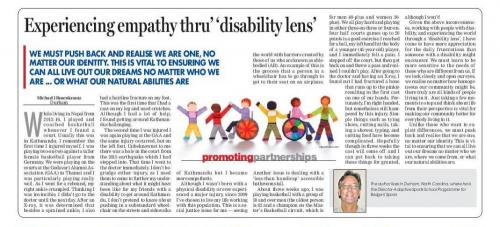
While living in Nepal from 2012–16, I played and coached basketball whenever I found a court. Usually this was in Kathmandu. I remember the first time I injured myself. I was playing 2 on 2 against a taller female basketball player from Germany. We were playing on the courts at the Godavari Alumni Association (GAA) in Thamel and I was playing really well. As I went for a rebound, my right ankle crumpled. Thinking I was invincible, I didn’t go to the doctor until the next day. After an X-ray it was determined that besides a sprained ankle, I also had a hairline fracture on my foot. This was the first time that I had a cast on my leg and used crutches. Although I had a lot of help, I found getting around Kathmandu challenging.
The second time I was injured I was again playing at GAA and the same injury occurred, but on the left foot. Unbeknownst to me there was a hole in the court from the 2015 earthquake which I stepped into. That time I went to the doctor immediately.
I don’t begrudge either injury as I used them to come to further my understanding about what it might have been like for my friends with a disability to get around Kathmandu. I don’t pretend to know about pushing in a substandard wheelchair on the streets and sidewalks of Kathmandu but I became more empathetic.
Although I wasn’t born with a physical disability or ever experienced a major injury, since 2009 I’ve chosen to live my life working with this population. This is a social justice issue for me, seeing the world with barriers created by those of us who are known as able-bodied (AB). (An example of this is the process that a person in a wheelchair has to go through to get to their seat on an airplane. Another issue is dealing with a “less-than handicap” accessible bathroom stall.)
About three weeks ago, I was playing basketball with a group of 50 and over men. (The oldest person is 82 and a champion on the Master’s Basketball circuit, which is for men 40+ and women 30+) We all play hard and playing in either 3 on 3 or 4 on 4 half courts games up to 20 points is good exercise. I reached for a ball, my left hand hit the body of a younger (45-year-old) player, and I immediately felt a pain. I stepped off the court, but then got back on and threw a pass and realized I couldn’t play. After going to the doctor and having, an X-ray I found out I had fractured a bone that runs up to the pinkie resulting in the first cast on one of my hands.
Fortunately, I’m right handed, but nonetheless still hampered by this injury. Simple things such as tying shoes, cutting nails, taking a shower, typing, and cutting food have become complicated. Hopefully though in three weeks the cast will come off and I can get back to taking these things for granted; although I won’t!
Given the above inconveniences, working with people with disability, and experiencing the world through a “disability lens,” I’ve come to have more appreciation for the daily frustrations that someone with a disability might encounter.
We must learn to be more sensitive to the needs of those who are different from us. If we look closely and open our eyes, we realize no matter how homogenous our community might be there truly are ALL kinds of people living in it. Just taking a few moments to stop and think about life from their perspective is vital for making our community better for everybody living in it.
Unlike those who want to exploit differences, we must push back and realize that we are one, no matter our identity. This is vital to ensuring that we can all live out our dreams no matter who we are, where we come from, or what our natural abilities are.










Add new comment